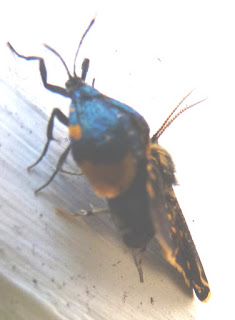Now how to contact the bio-security people? Why do government department have to keep changing their name? To hide away from the 'common' people? Or do they do it to show a new guy is in charge?
So no longer is there a DSIR - Department of Scientific and Industrial Research, founded in 1926. One always went their with their queries to identify strange plant, plant disease or insect etc. But it was Reconstituted into initially 10 semi-independent entities called Crown Research Institutes by the Crown Research Institutes Act 1992.
So try Ministry of Agriculture and Forestry - Commonly known as MAF - that was dissolved in 2012 and became Ministry for Primary Industries - but when googling that title it seems to keep coming back to the fishing industry.
By luck rather than remarkable skills in googling I finally got my answer from - wait for it...reckon you'll find it in the phone book real easy - NOT
IDCPHEL Auckland Public Enquiries <Auckland@mpi.govt.nz>
Hi Lois,
Thank you very much for your enquiry and photos. This is a
male and female lichen bag moth, Cebysa leucotelus [Lepidoptera:
Psycidae]. This Australian moth has been established in New Zealand since about
1981. The female is brightly coloured metallic blue with orange markings and is
sometimes mistaken for a beetle or wasp. The wings are never fully formed, so
she hops around but can’t fly. The male looks quite different and is brown and
cream/yellow in colour. The caterpillar lives inside a silken bag camouflaged
with bits of dirt stuck on the outside, and eats algae and lichen. When ready
to pupate, they often crawl upwards and hang quietly in the resting stage. They
may sometimes be seen hanging under the eaves of a building. They are not of
biosecurity concern. Thank you for your interest and for taking the trouble to
report it.
Kind regards,
Stacey
Stacey
Stacey Lamont | Entomology
Plant Health and Environment Lab | Diagnostic and Surveillance Services | Operations
Ministry for Primary Industries - Manatū Ahu Matua | 231 Morrin Road | PO Box 2095 | Auckland 1140 |
New Zealand
Web: https://www.mpi.govt.nz/protection-and-response/finding-and-reporting-pests-and-diseases/laboratories/plant-health-and-environment-laboratory/
Plant Health and Environment Lab | Diagnostic and Surveillance Services | Operations
Ministry for Primary Industries - Manatū Ahu Matua | 231 Morrin Road | PO Box 2095 | Auckland 1140 |
New Zealand
Web: https://www.mpi.govt.nz/protection-and-response/finding-and-reporting-pests-and-diseases/laboratories/plant-health-and-environment-laboratory/
Australian Lichen Bag Moth
------------------------------------------------------------------------------------------------------------------------------------------------
BELOW -
The common New Zealand Bag/Case Moth which we are familiar with in our gardens. We know them by the overnight torn edges and holes in the leaves of trees, lemon trees in particular in my garden and yet are so hard to detect as they look like small twigs. They feed on a very wide range of native and exotic broad-leaved and coniferous shrubs and trees. I think this is maybe the moth that was swarming this summer and the Islanders were wondering about?
See more at http://www.nzffa.org.nz/farm-forestry-model/the-essentials/forest-health-pests-and-diseases/Pests/Liothula-omnivora .




No comments:
Post a Comment